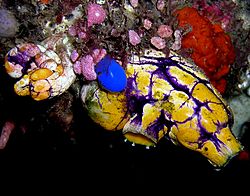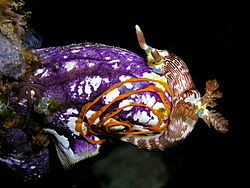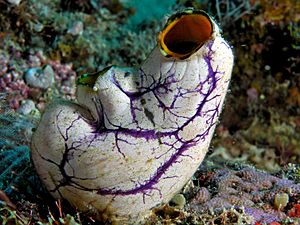Ox heart ascidian facts for kids
Quick facts for kids Polycarpa aurata |
|
|---|---|
 |
|
| Polycarpa aurata, purple and yellow variant | |
 |
|
| Nudibranch (Nembrotha lineolata) laying an egg spiral on a Polycarpa aurata off the coast of Metinaro, East Timor. | |
| Scientific classification | |
| Kingdom: | |
| Phylum: | |
| Subphylum: | |
| Class: | |
| Order: |
Stolidobranchia
|
| Family: |
Styelidae
|
| Genus: |
Polycarpa
|
| Species: |
P. aurata
|
| Binomial name | |
| Polycarpa aurata (Quoy & Gaimard, 1834)
|
|
| Synonyms | |
|
|
Polycarpa aurata, also known as the ox heart ascidian, the gold-mouth sea squirt or the ink-spot sea squirt, is a fascinating sea creature. It belongs to a group of animals called tunicates, which are simple marine animals. These animals live attached to surfaces on the ocean floor.
Contents
What Does Polycarpa aurata Look Like?
The Polycarpa aurata can grow to be about 5 to 15 centimeters (2 to 6 inches) tall. It has a unique urn-shaped body that is hollow inside. You can spot two openings, called siphons, on its body. One siphon is at the top, and the other is on the side.
Its body is usually white with bright purple and orange patches. You might also see thin purple lines running across its surface. The inside of its siphons is often a vibrant yellow or orange color, which makes them stand out.
Where Does Polycarpa aurata Live?
This sea squirt lives in the warm, tropical waters of the eastern Indian Ocean and the western Pacific Ocean. You can find it in places like the Philippines, Indonesia, and northern Australia.
It prefers to live in shallow to moderately deep waters. You can usually spot it at depths ranging from 5 to 50 meters (16 to 164 feet) below the surface.
How Does Polycarpa aurata Eat?
Polycarpa aurata is a filter feeder. This means it gets its food by drawing water into its body. It uses the branchial siphon, which is the opening at the top, to pull in water.
Inside its body, it has special filters that catch tiny food particles. These particles include phytoplankton (tiny plants), bacteria, and other small bits of food floating in the water. After filtering the water, the sea squirt expels the clean water back into the ocean through its atrial siphon, which is on its side.
Sometimes, other small sea creatures like hydroids and algae might grow on the outside of the Polycarpa aurata. Also, some types of nudibranchs, which are colorful sea slugs, like Nembrotha lineolata, sometimes feed on these sea squirts.
See also
 In Spanish: Polycarpa aurata para niños
In Spanish: Polycarpa aurata para niños


